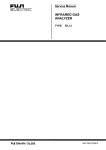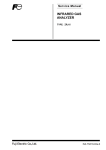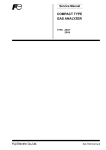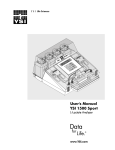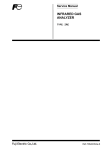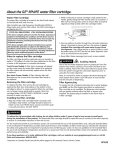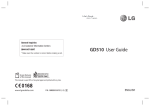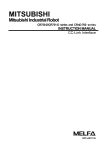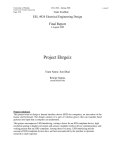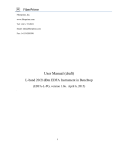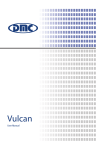Download Service Manual - Fuji Electric
Transcript
Instruction Manual INFRARED GAS ANALYZER TYPE: ZKJ-3 INZ-TN514722-E PREFACE This service manual describes the infrared gas analyzer (Type: ZKJ). This service manual is intended for use with the instruction manual to help you in understanding maintenance and inspection for the infrared gas analyzer (ZKJ). However, the basic operation of the analyzer is not covered in this manual. This manual provides information about the parameter settings in the factory mode, adjustment and precautions for parts replacement, and troubleshooting for the infrared gas analyzer (ZKJ) which are not covered in the instruction manual. This service manual gives you useful hints to take immediate remedy for after-sales service. • First read the instruction manual and service manual carefully until an adequate understanding is acquired, and then proceed to installation, operation and maintenance of the gas analyzer. Wrong handling may cause an accident or injury. • The specifications of this analyzer will be changed without prior notice for further product improvement. • Modification of this gas analyzer is strictly prohibited unless a written approval is obtained from the manufacturer. Fuji Electric will not bear any responsibility for a trouble caused by such a modification. Manufacturer: Type: Date of manufacture: Product nationality: Fuji Electric Instrumentation Co., Ltd. Described in Fuji Electric’s company nameplate on main frame Described in Fuji Electric's company nameplate on main frame Japan ©Fuji Electric Systems Co., Ltd. 2006 Issued in July, 2006 Request • It is prohibited to transfer part or all of this manual without Fuji Electric’s permission in written format. • Description in this manual will be changed without prior notice for further improvement. INZ-TN514722-E i CONTENTS PREFACE ..........................................................................................................................i CAUTION ON SAFETY .................................................................................................iii 1. STRUCTURE OF ANALYZER AND NAMES OF PARTS ......................................1 (1) Analyzer main unit ........................................................................................................... 1 (2) Measuring element ........................................................................................................... 3 (3) Connection of parts........................................................................................................... 5 2. MAINTENANCE AND INSPECTION, AND REPAIR AND ADJUSTMENT AT REPLACEMENT OF MEASURING UNITS .......................................................7 (1) (2) (3) (4) (5) (6) (7) Light source ...................................................................................................................... 7 Sector motor and sector .................................................................................................... 8 Reference cell ................................................................................................................... 8 Cell, cell window and O-ring ........................................................................................... 9 Detector (except for O2 sensor) ........................................................................................ 9 Built-in O2 sensor ........................................................................................................... 10 Printed circuit board ....................................................................................................... 11 1) Main printed circuit board (main board)...................................................................... 11 2) Amplifier printed circuit board (amplifier board)........................................................ 12 3) Mother printed circuit board (mother board) ............................................................... 13 4) I/O terminal printed circuit board (I/O terminal board) ............................................... 13 (8) Liquid crystal display (LCD).......................................................................................... 13 (9) Power supply .................................................................................................................. 13 (10) Membrane key ................................................................................................................ 14 3. FACTORY MODE.....................................................................................................15 (1) How to go to factory mode ............................................................................................. 15 (2) Contents and setting of each item................................................................................... 16 1) Zero offset.................................................................................................................... 16 2) A/D data ....................................................................................................................... 17 3) Other parameters.......................................................................................................... 18 4) Coefficient check ......................................................................................................... 20 5) Initial data ................................................................................................................. 21 6) Calculation ................................................................................................................... 22 4. ERROR JUDGEMENT CRITERIA FOR ERROR CODES .....................................23 (1) Countermeasures against trouble.................................................................................... 24 5. TROUBLESHOOTING AND DATA COLLECTION .............................................24 (2) Data sampling at trouble................................................................................................. 25 (3) Troubleshooting of detectors .......................................................................................... 26 1) Trouble judgment......................................................................................................... 26 2) A/D data ....................................................................................................................... 26 APPENDIX 1. MEASURING PRINCIPLE DIAGRAM............................................A-1 APPENDIX 2. SOFT FLOW DIAGRAM...................................................................A-2 APPENDIX 3. PRINTED CIRCUIT BOARD DIAGRAM ........................................A-3 ii INZ-TN514722-E CAUTION ON SAFETY First of all, read this “Caution on safety” carefully, and then use the analyzer in the correct way. • The cautionary descriptions listed here contain important information about safety, so they should always be observed. Those safety precautions are ranked in 2 levels, “DANGER” and “CAUTION”. DANGER Wrong handling may cause a dangerous situation, in which there is a risk of death or heavy injury. CAUTION Wrong handling may invite a dangerous situation, in which there is a possibility of medium-level trouble or slight injury or only physical damage is predictable. Caution on installation and transport of gas analyzer DANGER • This unit is not explosion-proof type. Do not use it in a place with explosive gases to prevent explosion, fire or other serious accidents. • This product must be installed in a place that meets the conditions specified in the “instruction manual.” Use of the analyzer in a place that does not meet the above conditions may result in electric shocks, fire or malfunction. CAUTION INZ-TN514722-E • During installation work, attention should be paid not to allow entrance of wire fragments or other foreign matter into the product. Otherwise, a fire, trouble or malfunction may be caused. • When the gas analyzer needs to be lifted, be sure to put on protective gloves. Don’t hold the analyzer with bare hands to prevent injury. • Before transporting the analyzer, fix its casing so as not to open. If the casing is separated and falls, injury may be caused. • The gas analyzer is heavy. For carrying the analyzer manually, have at least two persons conduct it with utmost care. If this caution is ignored, body damage or injury may be caused. iii Caution on piping In piping, the following precautions should be observed. Wrong piping may cause gas leakage. If the leaking gas contains a toxic component, there is a risk of serious accident being induced. Also, if combustible gas is contained, there is a danger of explosion, fire or the like occurring. DANGER • Connect pipes correctly referring to the instruction manual. • Exhaust should be led outdoors so that it will not remain in the locker and installation room. • Exhaust from the analyzer should be relieved in the atmospheric air in order that an unnecessary pressure will not be applied to the analyzer. Otherwise, any pipe in the analyzer may be disconnected to cause gas leakage. • For piping, use a pipe and a pressure reducing valve to which oil and grease are not adhering. If such a material is adhering, a fire or the like accident may be caused. Caution on wiring CAUTION • The specified grounding construction is a requisite. Negligence of grounding may cause electric shocks or malfunction. • Be sure to use a power supply of correct rating. Connection of power supply of incorrect rating may cause fire. • Wiring work must be performed with the main power set to OFF to prevent electric shocks. • Wires should be the proper one meeting the ratings of this instrument. If using a wire which cannot endure the ratings, a fire may occur. Caution on use iv DANGER • When handling standard gas such as calibration gas, read the instruction manual for the standard gas for correct handling. CAUTION • Avoid continuous operation with the casing drawn out. Otherwise, the casing may fall to cause injury. • During operation, never touch the inside with the casing open, because there is a danger of burns or electric shocks. INZ-TN514722-E Caution on maintenance and check DANGER • Before accessing the inside of analyzer with the casing open for capillary replacement or the like purpose, be sure to turn off power supply and purge not only the analyzer inside but also the measuring gas line and auxiliary gas line adequately with the air or N2 gas. Also, carefully prevent oil, etc. from sticking to the capillary, filter, packing and the like parts. This is required for preventing poisoning, fire and explosion due to gas leak, etc. CAUTION • Before starting the work, take off metallic parts such as wrist watch and ring, and never touch the device with wet hands. Otherwise, electric shocks may be caused. • When the fuse is blown, detect its cause and use a new fuse of the same type and capacity as those of the old one to prevent electric shocks or other trouble. Others • If the cause of any fault cannot be determined despite reference to the CAUTION INZ-TN514722-E instruction manual, be sure to contact your dealer or Fuji Electric’s technician in charge of adjustment. If the instrument is disassembled carelessly, you may have a shock hazard or injury. • Don’t use replacement parts which are not specified by Fuji Electric. Use of such parts will not only degrade performance but also result in an accident or trouble. • The old parts after replacement due to maintenance, etc. must be disposed of as incombustible waste. v 1. STRUCTURE OF ANALYZER AND NAMES OF PARTS (1) Analyzer main unit 1 2 5 7 6 3 4 Parts No. 1 2, 4 3 5 6 7 INZ-TN514722-E Part name Top cover Mounting screw Slide rail Input/output terminal Input/output cable Power supply cable 1 9 11 10 11 15 B 5 A 16 6 D 13 C 14 7 2 18 17 3 4 F E B A C D 1 8 Parts No. 1 2 3 4 5, 6, 7 2 Part name Decorative sheet (with built-in keys) LCD panel Fuse holder Glass-tube fuse Switching power supply Parts No. 8 9 10 11 13 Part name Gas inlet/outlet fittings Main P.C.B Mother P.C.B Amplifier P.C.B Built-in paramagnetic O2 sensor INZ-TN514722-E (2) Measuring element For combination of 1 optical block with one sample cell 26 20 15 17 18 16 19 25 24 23 14 21 23 10 ネジ 11 23 6 1 22 24 9 21 13 2 4 12 26 25 3 24 8 23 26 21 22 7 5 Parts No. Part name Parts No. Part name Parts No. Part name 1 Sector motor 10 Cell window (for pipe cell) 18 O-ring 2 (for block cell) 2 Motor mounting plate 11 Reference cell 19 Cell window (for block cell) 3 Sector 12 Sample cell 20 Block cell 5 Infrared light source 13 Trimmer assembly 21 Measurement detector 6 Light source unit cover 14 Cell pushing 23 Light control plate 7 Photo-interrupter 15 Window pushing 24 Interference compensation detector 8 Distribution cell 16 O-ring 1 (for block cell) 25 Light shielding plate 9 O-ring (for pipe cell) 17 Washer INZ-TN514722-E 3 For combination of 1 optical block with 2 sample cells 26 14 9 10 25 11 24 23 22 screw 21 12 21 13 1 6 2 4 20 8 26 3 5 4 7 INZ-TN514722-E INZ-TN514722-E blue 3 2 4 Noise filter 1 1a 2 2a KEY SW LCD black LDA10F-5 Power supply unit LDA75F-18-Y(for optical block 1) red A LED K CN4 CN5 CN4 CN3 CN2 CN1 CN12 CN13 CN8 CN9 CN6 2nd component interference compensation detector 2nd component mesuring detector 1st component interference compensation detector 1st component mesuring detector Amplifier board No. 1 Main board Amplifier board No. 2 O2 sensor CN3 4th component mesuring detector CN2 CN1 CN7 CN10 4th component interference compensation detector CN2 To main PC board CN6 3rd component interference compensation detector 3rd component mesuring detector Photo-interrupter for optical block 1 CN11 Mother board Light source for optical block 2 Light source for optical block 1 Motor for optical block 2 Motor for optical block 1 Motor driver for optical block 2 Motor driver for optical block 1 Note) The parts specified for optical block 2 and amplifier board No. 2 are not mounted to the analyzer which does not have the second optical block. The number of detectors varies with the number of gas components and measurement range. Photo-interrupter for optical block 2 Power supply unit LDA75F-18-Y(for optical block 2) LDC30F-2 Power supply unit LDC60F-2 DISPLAY SW brown 1 POWER SW Fuse holder Inlet (3) Connection of parts • Connection diagram 5 • Piping diagram O2 sensor Infrared light source side Toaron φ6/φ3 Sample cell (1st optical block) Toaron φ6/φ3 Yellow capillary L=20mm Teflon φ6/φ4 INLET CH1 CH2 Yellow capillary L=10mm(Toaron φ9/φ5 L=35) OUTLET INLET CH3 CH4 OUTLET Toaron φ9/φ5 Sample cell (2nd optical block) Infrared light source side "0" indicates a hose band. For pipe joint, use Toaron φ9/φ6. Block cell (2nd optical block) This is a piping diagram of the analyzer without a purging line. When the O2 meter and the second optical block are not provided, pipes must be connected by bypassing them. O2 sensor Infrared light source side Toaron φ6/φ3 Sample cell (1st optical block) Toaron φ6/φ3 Yellow capillary L=20mm Teflon φ6/φ4 Toaron φ9/φ5 INLET Toaron φ9/φ5 Yellow capillary L=10mm(Toaron φ9/5 L=35) OUTLET Toaron φ9/φ5 PURGE Sample cell (2nd optical block) Infrared light source side "0" indicates a hose band. For pipe joint, use Toaron f9/f6 Block cell (2nd optical block) This is a piping diagram of the analyzer with a purging port. When the O2 meter and the second optical block are not provided, pipes must be connected by bypassing them. 6 INZ-TN514722-E MAINTENANCE AND INSPECTION, REPAIR 2. MAINTENANCE AND INSPECTION, ANDAND REPAIR AND AND ADJUSTMENTATAT REPLACEMENT OF MEASURING ADJUSTMENT REPLACEMENT OF MEASURING UNITSUNITS (1) Light source • Recommended period of replacement : 5 years 1) Error mode : Short circuit in and disconnection from the light source electrically heated wire. Phenomena : Scale-out indication of analyzer. Check : Turn OFF the power of the analyzer and remove the power cable connected to the light source. (Unplug the CN8 and CN9 connectors on the mother board.) Make sure a voltage of 19.8 ± 0.5 V is output between pins 1 and 2 of CN8 or CN9 on the mother board. Measure the resistance between the terminals of the connector (having 2 pins) on the light source side. Infrared light source Resistance between these terminals The measured value is normally 20 Ω ± 2 Ω. When the resistance value is infinite, cabling is discontinuous. As the resistance value decreases, the span narrows (sensitivity is degraded). To mother board CN8 or CN9 2) Error mode Phenomena Check : Sealed gas in light source leaks. : Fluctuated indication : If the analyzer output is drifted due to ambient conditions around the analyzer and other units are normal except for the light source, sealed gas may leak. 3) Error mode Phenomenon : Separation of light source fixing spring : Analyzer’s indication of measured value is unstable or surpasses the scale, and optical balance cannot be adjusted. : Remove the light source unit and check it visually. Check • Measures : If the light source is found defective, replace the light source unit. • Replacement : Unplug connectors CN8 (for 1st optical block) and CN9 (for 2nd optical block) on the mother board. Open the light source unit cover, remove the two screws which fasten the light source and replace the light source unit with a normal one. • Adjustment after replacement : Optical balance adjustment and zero/span calibration INZ-TN514722-E 7 (2) Sector motor and sector • Recommended period of replacement : 2 years (Sector motor) 1) Error mode : Motor rotation stop Phenomena : Analyzer’s measured value surpasses the scale or indicated value does not change, and ERROR-1 occurs. Check : With the analyzer powered on, remove the light source cover and make sure the sector is rotating. 2) Error mode : Unstable rotation or stop of a sector Phenomena : Scale-out indication of analyzer: Error- 1 occurs. Indication is fluctuated. Check : With the analyzer power ON, check if unusual noise is generated from the motor due to metal contact. (Sound at a constant high frequency is not abnormal.) If no noise is heard, remove the light source unit cover. Turn ON the power of the analyzer and check the rotation of motor shaft and sector • Measures : If the sector motor is defective, it must be replaced with a new one. • Replacement : Detach the light source unit cover. Unplug the connector which is connected from the motor to the motor driver and pull the cable out of the cubicle through the grommet hole. Remove four screws (M4) from the motor mounting plate which is fastened to the base of light source unit, and the motor and sector can be pulled out. The sector can be separated by removing the sector setscrew which fastens the sector to the motor shaft, and then the motor can be separated by removing four screws from the motor mounting plate. Fasten a replacement motor to the mounting plate and mount the motor by reversing the demounting procedure. For mounting the motor, rotate the sector manually before fixing the motor cover, and make sure the sector does not come in contact with the light source base, light source, photo-interrupter, wires, etc. (frictional sound must not be emitted). Finally, fix the light source unit cover. • Adjustment after replacement: Check of optical balance (adjust if significantly deviated) and calibration of zero/span points (3) Reference cell • Recommended period of replacement: 5 years Error mode : Leakage of gas filled in cell Phenomenon : Analyzer’s measured value is unstable (in particular, stability against change in ambient temperature is degraded). • Measures : Replacement of reference cell • Replacement : Remove the reference cell and mount a new one. • Adjustment after replacement: Optical balance adjustment, moisture interference adjustment and zero/span calibration 8 INZ-TN514722-E (4) Cell, cell window and O-ring • Service life : Usable unless contaminated or corroded. • Recommended period of replacement : 2 years with O-ring 1) Error mode : Contamination of cell, mixture of foreign matter, and contamination of cell window Phenomena : Scale-out indication, drift and calibration error occurred to analyzer Check : Disassemble the cell to assure that the inside is clean. 2) Error mode : Crack in cell window Phenomena : No change in indication, slow response, calibration error, and indication fluctuation Check : Perform a visual check of the cell window. • Measures : Cell : Clean the inside of the cell (refer to the instruction manual for details). Replace If the inside is exposed to excessive contamination or corrosion. Cell window : Clean the cell window. Replace if the inside is exposed to excessive contamination. • Adjustment after clean and replacement : Check of optical balance (adjust if significantly deviated) and calibration of zero/span points and response. (5) Detector (except for O2 sensor) • Recommended period of replacement : 5 years 1) Error mode : Damage to mass-flow detector Phenomena : Scale-out indication of analyzer , calibration error occurs. Check : Turn OFF the power of the analyzer and disconnect the connector connected from the detector to PC board. Measure each resistance between GND and S1 on the PC board of detector and between GND and S2. The measure values must be between 25Ω and 60Ω. If the resistance value is beyond the specified range, the detector element may be damaged. Note) For resistance measurement, avoid using a measuring device such as analog tester that flows a current of 2 mA or more. If used, the detection element may be damaged. 2) Error mode Phenomena Check • Measures INZ-TN514722-E Detector S1 GND S2 PC board 1 2 3 4 red brown red white To amplifier board : Sensitivity deterioration due to sealed gas leak : Calibration error, fluctuation in indication and poor stability of analyzer’s measured value : After making sure the light source is normal and the cell is clean, check moisture sensitivity. (For the method of fault judgment and sensitivity check, refer to “5(3) Troubleshooting of detectors” in “5. TROUBLESHOOTING AND DATA COLLECTION.”) : Replace detector. 9 • Replacement : Turn off power supply to the analyzer, remove the bolts which fix the detector and remove the detector. Mount a new detector and tighten the bolts. The type of detector varies with the gas component to be measured. So before mounting, check the symbol marked on the detector label. • Adjustment after replacement : Optical balance adjustment, moisture interference adjustment and zero/span calibration ○○○○○○○○ R1,2 =○○○ R3,4 =○○○ R* =○○○ A1 Detector type (6) Built-in O2 sensor • Recommended period of replacement : 10 years • Error mode : Breakage of O2 sensor • Phenomenon : Zero is read on the O2 meter and the reading remains unchanged even for the span gas. • Check : Confirmation of O2 input voltage --- Measure the voltage between check terminals TP4 and SC on the main PC board using a digital voltmeter, and make sure the voltage is about 0 V for zero gas and 0.5 to 1 V for span gas. If the voltage does not change between the zero and span gases, the O2 sensor is damaged. • Measures : Replacement of O2 sensor • Replacement : Turn OFF the analyzer main unit Unplug the O2 sensor connector. Then, remove the screws which fasten the O2 sensor mounting plate to the main frame and separate the O2 sensor together with the mounting plate. The O2 sensor is fixed by screws from the rear side of the mounting plate. So remove the screws to detach the O2 sensor. A new sensor is mountable by reversing the above procedure. • Adjustment after replacement : Zero and span calibration 10 INZ-TN514722-E (7) Printed circuit board (see printed circuit diagram at the back of the manual) 1) Main printed circuit board (main board) Note) The main board is set according to the specifications of each analyzer. When placing an order for a replacement PC board, notify the serial number of your analyzer in advance so that the new board will have suitable parameters in it. • Check : Check of circuit voltage Check terminal GND1-Vcc VG1-P15 VG1-N15 GND1-3.3V GND2-TP10 Adjusting VR VR4 Regulated voltage +5±0.2V +15±0.5V -15±0.5V +3.3±0.1V About +26 V Contents Digital 5 V Analog 15 V Analog -15 V Digital 3.3 V LCD drive voltage, contrast adjustment • Precautions on replacement: • The cable (connector CN2) from LCD is connected to the main printed circuit board. Do not unplug or plug the connector from or into the board with the analyzer power ON, or the electronic parts and indication block may be damaged. Before replacement, be sure to turn OFF the analyzer. • The cable (connector CN5) from the membrane key is connected to the main printed circuit board. Since a stopper is provided on the CN5 connector, the flexible cable should not be pulled forcibly. Forcible pulling may result in poor contact. For disconnecting the flexible cable, slide the stopper lightly toward you by holding both sides of CN5 with fingers. And for reconnecting the flexible cable, insert it fully down to the bottom and attach the stopper. (The flexible cable should be inserted with its contact face directed toward the printed circuit board.) • Adjustment after replacement: • INZ-TN514722-E The above-mentioned voltage check/adjustment and contrast adjustment (VR4). Contrast should be adjusted so as to be easy to see indications at the height of your eyes. In factory mode, zero offset adjustment, output adjustment, Moisture interference adjustment and zero/span calibration. 11 2) Amplifier printed circuit board (amplifier board) One board provided for each optical block (the following check items are for one board) • Check : Check of circuit voltage Check terminal Regulated voltage Contents a b SG-P15 SG-N15 +15±0.5V -15±0.5V c N15-DV1 +17.5±0.5V d N15-DV2 +17.5±0.5V e SG-TP5 +2.5±0.1V +15 V power supply -15 V power supply 1st component detector power supply (used in common for Main and Compo.) 2nd component detector power supply (used in common for Main and Compo.) Reference voltage for A/D conversion Check of signal processing block: Unplug all connectors of the cables from the detector. Display the screen for “11. A/D Data” in Factory Mode. In the A/D Data screen, numbers 0 to 3 stand for signals from the amplifier board for the 1st optical block and numbers 4 to 7 stand for signals from the amplifier board for the 2nd optical block. Check if the count value in each number lies within a range of 15000 ± 1000. Detector signal check (check by flowing the following gases) Check terminal Under zero gas flow Under span gas flow SG-TP1 1.0 to 2.0Vp-p SG-TP2 - Under 2°C-wet zero gas TP1 and TP2 at almost the same magnitude ST-TP3 1.0 to 2.0Vp-p TP3 and TP4 at almost 8.33 Hz, 0.2 Vp-p max. in AC the same magnitude SG-TP4 signal width * TP2 and TP4 signals are 0 V when the lower end of measuring range is 0 to 10% or more. • Precautions on check: The amplifier board is connected to the mother board by connector. If the connector is not plugged in adequately, the above check may not bring about a normal result. Before check, make sure the connector is plugged in correctly. • Precautions on replacement: A cable from the detector is connected to the amplifier board. If the connector is unplugged or plugged in with the analyzer power ON, the detector may be damaged. Before replacement, be sure to turn off the power supply. • Adjustment after replacement: Verification of the contents of the above checks, adjustment as per “4. Zero Offset” in Factory Mode and zero/span calibration 12 INZ-TN514722-E 3) Mother printed circuit board (mother board) • Adjustment after replacement: Output adjustment (Refer to “ Output Adj.” in Maintenance Mode.) 4) I/O terminal printed circuit board (I/O terminal board) • Adjustment after replacement : Output check (Adjust if output is offset. Refer to “10. Output Adj.” in Factory Mode.) (8) Liquid crystal display (LCD) • Service life of parts : 5 years • Error mode : Deterioration • Phenomena : LCD is not displayed, or the display is dim or flickers. • Check : Check LCD drive voltage on the main board. Check connection to the main board. (See “Check for printed circuit board”) • Countermeasures against error : Replace LCD. • Replacement : Turn OFF the power. Disconnect the connector from the main printed circuit board and replace it with a new one. • Adjustment after replacement : Check the drive voltage and adjust the contrast (9) Power supply • Recommended period of replacement : 5 years • Error mode : Power-down • Phenomena : No display and no output • Check : Check if short circuit occurs. Disconnect the secondary SW power connector. Turn ON the power and check the voltage at the connector. If no voltage is applied to it, replace. • Measures : Replace the S.W. power supply • Replacement : Turn OFF the instrument power. replace it with a new one. Disconnect the connector from the motherboard and • Check after replacement : Check the power supply voltage on the main printed circuit board. INZ-TN514722-E 13 LDC30F-2 LDC60F-2 Name plate Name plate Input(N) Output(L) Pin 1 2 3 4 5 6 Symbol V3 G2 G2 V2 G1 V1 Pin 1 2 3 4 5 6 7 8 Voltage –15V +15V +5V Symbol V3 G2 G2 V2 G1 G1 V1 V1 Voltage –15V +15V +5V +5V LDA10F Pin 1 2 3 4 Output (+) Output (–) Symbol –V –V +V +V Voltage +5V +5V Name plate CN1 FG Input(N) Input(L) Name plate Output(-) Output(+) Pin 1 to 3 4 to 6 Symbol –V +V Voltage +19.8V CN2 Output voltage variable resistor (10) Membrane key • Error mode : Key contacts are worn. • Phenomena : It prevents the switch from being operated. • Check : Check for the contacts with main printed circuit board • Measures : Replace the membrane key. • Replacement : Turn OFF the power. Disconnect the connector from the main print circuit board. Remove soldered portion of the power switch and remove the power switch from the main instrument. Strip off membrane key and adhesives are wiped off completely. Then, replace it with a new one. Remove the power switch and install it in the reverse procedure as removal. Connect the key cable to the connector of the main print circuit board. • Check after replacement : Check key-in operation. 14 INZ-TN514722-E 3. FACTORY MODE (1) How to go to factory mode Point the cursor to “8. To Factory Mode” by using the or key on the Maintenance Mode screen and enter the ENT key. Then, the password input screen appears. ENT Enter the password. To select setting items, set “4 0 4 3”. (“4.Zero offset Adj.”, “10. Output Adj.”, “12. Others.” and “15.Coefficient ”are settable with “4043.” Items 1, 2, 3, 5, 6, 7, 8, 9, 11, 13, 14, 16 and 17 can be viewed.) key. Select digits by the Change numerical values by using or key. After password entry has been completed, press the ENT key, and the Factory Mode initial screen appears ENT How to select setting item from Factory Mode screen On the Factory Mode screen that appears, point the cursor , or key. to the item you want by using the To get access to each setting screen, press the ENT key. To return from each setting screen to the initial screen, press the -5+ key. -5+ -5+ Into each parameter screen When escaping from the Factory Mode screen to the Maintenance Mode screen, press the -5+ key. INZ-TN514722-E 15 (2) Contents and setting of each item 1) Zero offset • Function : Stores the offset value of the A/D converter. • Operation : The offset adjustment screen is shown at right. Be sure to remove the cable of the detector from the amplifier board before making the adjustment. Select a component to be adjusted using the Factory mode initial screen The cursor is in 4 ENT -5+ and keys. Press the ENT key to confirm the selection. Press the ENT key again, and the offset value is stored. Press the -5+ key to exit without making the adjustment. Select ALL Ch, and adjustment can be made simultaneously for the Chs except for O2. Before adjusting the O2 offset value, be sure to remove the connector of the built-in O2 sensor, and then short-circuit O2_IN (between 1-2 of TN2) on the external terminal bock, or input 0V. The stored offset value appears on the screen. 16 INZ-TN514722-E 2) A/D data • Function • Operation : Measures the counter readings immediately after A/D conversion. : To measure the counter readings, press the ENT key on the “Factory Factory mode initial screen The cursor is in 11 ENT -5+ Mode” initial screen. Ainp No. 0 1 2 3 4 5 6 7 Type Optical block 1-1, Main Optical block 1-1, Compo. Optical block 1-2, Main Optical block 1-2, Compo. Optical block 2-1, Main Optical block 2-1, Compo. Optical block 2-2, Main Optical block 2-2, Compo. Ainp No. Type 8 Oxygen input 9 Temperature 10 - 11 - 12 13 14 15 Optical block 1 motor pulse + Optical block 1 motor pulse Optical block 2 motor pulse + Optical block 2 motor pulse - When supplying zero gas (dry); No. 0 to 7 (infrared component) : No problem within 10000 to 22000 (However, ignore the values where no detector is available.) No. 8 (oxygen sensor input) : No problem within 10000 to 18000 (However, if an oxygen meter is not provided, ignore this input.) No. 9 (temperature sensor input) : No problem within 5000 to 18000. No. 12 to 15 : No problem within 58000 to 61000 (If the 2nd optical block is not provided, ignore Nos. 14 and 15.) INZ-TN514722-E 17 3) Other parameters • Function : Used to set the following. • Operation : The “Other parameters” screen is shown at right. Select the setting contents using the and keys. Factory mode initial screen The cursor is in 12 ENT -5+ ENT ENT Press the ENT key, and the setting is highlighted. Switch the setting using the and keys. Press the ENT key to confirm the setting. -5+ Press the -5+ key not to confirm the setting. Setting contents • Zero limit : The fractional value can be displayed or omitted. ON: Select ON not to display the fractional value. OFF: Select OFF to display the fractional value. Initial value: “ON” * Select OFF to check the fractional portion of the displayed value when making adjustment. Be sure to set it back to “ON” when checking work is completed. • Range limit : Selection can be made from limiting or not limiting the instantaneous concentration value to be used for calculation of oxygen conversion value or average conversion value at 110% of the range. ON: Measurement value of up to 110% of the range can be used for calculation. OFF: Values up to the measurement limit can be used. Initial value: “ON” • Calibration concentration zero variable : Set it to “ON” to select a value other than 0 in zero calibration. The setting of zero calibration concentration can thus be varied. ON: Values other than 0 can be selected as zero calibration concentration. OFF: Zero calibration concentration is fixed to 0. Initial value: “OFF” 18 INZ-TN514722-E • Error 10 check : Selection can be made from checking and not checking errors that may occur when connection of I/O terminal is erroneous. ON: Performs Error10 check. OFF: Does not perform Error10 check. Initial value: “ON” • ZERO gas : Gas in cylinder or air can be selected as zero gas. Cylinder: Cylinder gas (N2, air cylinder) is used. Air: Air is used. Note that the operation of the solenoid valve for calibration varies depending on the setting. • MODBUS : Selection can be made from using and not using communication function via MODBUS protocol. ON: MODBUS communication is used. OFF: MODBUS communication is not used. • Range variable : The range modification function in maintenance mode can be enabled/disabled. ON: The range modification function in maintenance mode is enabled. OFF: The range modification function in maintenance mode is disabled. Initial value: “ON” INZ-TN514722-E 19 4) Coefficient check • Function : Used to display and change calibration coefficient. • Operation : The initial screen for coefficient check is shown at right. Select a desired item using the and Factory mode initial screen The cursor is in 15 ENT -5+ ENT -5+ keys. Press the ENT key to enter the screen of the item selected. • Zero selection Displayed per Ch R1: Zero Subtraction of range 1 From left: Main, Compensation, After M-C R2: Zero Subtraction of range 2, Meaning is the same is above. • Span selection Displayed per Ch R1 and R2 represent span calibration coefficient for range 1 and 2 respectively. The value at right (1.0000) is not used at R1. In case of selection of span Move the cursor in front of the value to be changed using the keys and then press the ENT key, and the value is highlighted. Change the value using the keys, and move to the next digit to be changed. When the change is completed, press the ENT key to confirm the change. Press the -5+ key not to confirm the change. 20 INZ-TN514722-E 5) Initial Data • Function • Operation : Used to memorize the interference coefficient, and the span and the sensitivity to moisture of each detector at the time of delivery. The change from the factory mode setting can thus be checked. Factory mode initial screen The cursor is in 16 ENT -5+ ENT -5+ : The factory mode initial screen is shown at right. Select the value to be changed using the keys, and press the ENT key to highlight the value selected. Change the value using the keys, move the cursor to the next digit to be changed. When change is completed, press the ENT key to confirm the change, and press the -5+ key not to confirm the change. Setting contents Infrared component only can be set per Ch. M represents Main, while C represents Compensation of the detector. CP : Sets the correction coefficient of <Maintenance> <5. Moisture interference adjustment> (at the time of delivery). SPAN : Span sensitivity in the minimum range at the time of delivery. H2O : Sensitivity to moisture in the minimum range at the time of delivery (Values for SPAN and H2O represent the range of the count.) INZ-TN514722-E 21 6) Calculation • Function : Displays the result of calculation for each component. Factory mode initial screen The cursor is in 17 • Contents : Displays infrared component and results of calculation by oxygen analyzer, etc. ENT -5+ ENT -5+ Display contents (when infrared component is selected) (X: Main, Y: Component) X, Y = A/D conversion input value X, Y1 = After offset X, Y2 = Scale conversion X, Y3 = Filter X, Y4 = Zero calibration (for each of Main and Compensation) X, Y5 = Span temperature correction X6 = Interference correction X7 = Zero temperature correction X8 = Zero calibration X9 = Span calibration X10 = Linearize X11 = Interference correction (when an analyzer other than zirconia O2 analyzer is selected) X = A/D conversion input value X1 = After offset X2 = Scale conversion X3 = Filter X4 = Zero point temperature correction X5 = Zero calibration X6 = Span temperature correction X7 = Span calibration X8 = Linearize (when a zirconia O2 analyzer is selected) X = A/D conversion input value X1 = After offset X2 = Filter X3 = Input conversion (Zero/span calibration) X4 = Linearize Operation : Press the ZERO key, and the contact for zero solenoid valve is set to ON. Press it again and it is set to OFF. Press the SPAN key, and the contact for solenoid valve of the channel displayed is set to ON. Press it again to set it to OFF. Press the ENT key to stop the value. 22 INZ-TN514722-E 4. ERROR JUDGEMENT CRITERIA FOR ERROR CODES * This section covers the error judgement criteria for error codes. For the contents of errors, refer to Instruction Manual. Error No. Contents Criteria Error 1 Motor rotation detector Detector signals generated due to motor chopping are converted into signal is faulty. rectangular waves and rectangular waves are monitored. If waves are not generated or irregular, an error occurs. A/D conversion value (count) can be checked on the A/D data indication screen in the factory mode. 59000 < Ainp No. 12, 13, 14, 15 < 61000 Error 4 Zero calibration is not If the following ranges are not met in zero calibration, an error occurs. within the allowable range Infrared component: 5000 <A/D conversion value in zero calibration < 25000 Paramagnetic oxygen: 8000 < A/D conversion value in zero calibration <14000 Zirconia oxygen: 10000 < A/D conversion value in zero calibration < 13000 Error 5 An amount of zero This error occurs in the following condition. calibration is over 50% 50% of FS < (Zero calibration concentration set value) – (current of full scale. display) Error 6 Span calibration is not When span calibration coefficient is not within the following range, within the allowable range. error occurs. Infrared component: 0.05 < span calibration coefficient < 10.0 Paramagnetic oxygen: 0.5 < span calibration coefficient < 16 Zirconia oxygen: 12000 < A/D conversion value in Span calibration < 16000 Error 7 An amount of span This error occurs in the following condition. calibration is over 50% 50% of FS < (Span calibration concentration set value) – (current of full scale. display) Error 8 Measured values fluctuate If A/D conversion value fluctuates beyond each range specified below to much during zero and in calibration, an error occurs. span calibration Infrared component, paramagnetic oxygen meter: A/D input value ± 100 Zirconia oxygen: Oxygen concentration after mV conversion ± 0.2 mV Error 9 Calibration is abnormal Error corresponding to No. 4 to No.7 occurs during auto calibration during auto calibration Error 10 Output cable connection is Error occurs if no response is made from the output IC improper. Main portions to be checked during error Error No. Error 1 Error 4 Error 5 Error 6 Error 7 Error 8 Error 9 Error 10 INZ-TN514722-E Main portions to be checked Sector motor rotation, mother and amplifier printed circuit board synchronization signal, rectangular waves between GND and MPD3 on main printed circuit board (8.33 Hz, 5 Vp-p) See service manual “5. (1) No zero calibration can be performed”. See service manual “5. (1) No span calibration can be performed”. See service manual “5. (1) Zero calibration and span calibration can not be performed”. Contact portions of main printed circuit board and motherboard printed circuit board (plug-in connector). Contact portions of mother printed circuit board and output printed circuit board (cable). 23 5. TROUBLESHOOTING AND DATA COLLECTION (1) Countermeasures against trouble 1) No zero calibration can be performed (ERROR No. 4, 5 or 8 has occurred.) 1) Check that a specified flow rate of zero gas is supplied to the analyzer main unit ⇒ Locate a gas leaked portion and remedy. 2) Check optical balance. (Refer to “optical balance adjustment” in instruction manual.) ⇒ Adjust optical balance. 3) Check the A/D data against the display. (Refer to “Sensor Input Value” in Maintenance Mode.) 4) If this trouble has occurred on the zirconia O2 measurement, check the sensor output voltage. 5) If ERROR No. 5 has occurred, carry out zero calibration forcibly and check the result. ⇒ If ERROR No. 4 occurs, return to above. 2) No span calibration can be performed (ERROR No. 6, 7 or 8 has occurred.) 1) Check that specified flow rate of span gas is supplied to the analyzer main unit. ⇒ Locate a gas leaked portion and remedy. 2) Check that zero calibration can be properly performed. ⇒ If zero calibration cannot be performed, repeat the procedure in “No zero calibration can be performed” described above. 3) Check the A/D data against the display. (Refer to “Sensor Input Value” in Maintenance Mode.) ⇒ Check for change from when flowing the zero gas. 4) Check the amplifier PC board. (Refer to “amplifier printed circuit board” in this manual.) 5) If this trouble has occurred on the zirconia O2 meter, check the sensor output voltage. 6) If ERROR No. 7 has occurred, carry out span calibration forcibly and check the result. ⇒ If ERROR No. 6 occurs, return to above. 3) Error occurs in automatic calibration. (ERROR No. 9 has occurred.) Depending on whether the error has occurred in zero calibration or span calibration, the relevant measure described above should be taken. 4) Drift 1) Check that specified flow rate of measured gas is supplied to the analyzer main unit. ⇒ Locate a gas leaked portion and remedy. 2) Check that the cell window, O-ring, detector window and cell inside are not contaminated. ⇒ Clean the cell and window. Replace parts. 5) Readings are high or low too much. 1) Check for influence by moisture interference. ⇒ Carry out moisture interference adjustment. 2) Check if the concentration of interference component in measured gas is too high. ⇒ Moisture should be below 2°C saturation. Check for other interference components. gas.) (Ask the user what components are contained in measured 6) Readings are not increased 1) Check that specified flow rate of measured gases are supplied to the analyzer main unit. ⇒ Locate a gas leaked portion and remedy. 2) Check that zero and span calibration can be performed. ⇒ If possible, check for sampling system (related to measured gas) and take remedies. ⇒ If not possible, check the item 1) and 2). 24 INZ-TN514722-E (2) Data sampling at trouble When trouble occurs, be sure to sample the following data. In the case of the trouble in connection with the characteristic, please sample data (please surely sample data to a factory at the time of an inquiry). Supply the gas given in Table and sample the measured value of measurement screen, sensor input values in maintenance mode. On the measured component that caused a trouble, supply the gas given in the following table, and write down the measured value of measurement screen and “Sensor Input Value” in Maintenance Mode. Measurement component and range Supply gas Zero gas Span gas 2°C-wet zero gas Sample gas Component Calibration concentration set value Range 1 Measurement display value Range 2 Sensor input value in maintenance mode (Main) Sensor input value in maintenance mode (Compo.) Range 1 Range 2 Range 1 Range 2 Range 1 Range 2 Range 1 Range 2 • If there is no Range 2, the part of a Range 2 is entry needlessness. • If trouble occurs to other components, sample data for each component. • If trouble occurs on the O2 meter, there is no sensor input value for Compo. Check each coefficient by “Coefficient” in the factory mode. Channel No. Offset Moisture interference Zero coefficient Range 1 CH1 Span coefficient Range 2 • Sampling system diagram If sampling system diagram is prepared, report the diagram number. If sampling system diagram is not prepared, report the sketch. For other troubles, sample various data about necessary setting items. INZ-TN514722-E 25 (3) Troubleshooting of detectors 1) Trouble judgment a. Check that the sampling line is not abnormal and that the dehumidifying line/filter status and sample gas properties do not have a problem. b. Check that other units and functions of the analyzer are not abnormal. Make sure the light source, sample cell and synchronization signal circuit do not have a problem. c. Examine each correlation with the ambient temperature and plant operating conditions (such as gas and heat radiation). 2) A/D data For generation of 2°C-wet zero gas, use a reliable bubbler and electronic cooler. Check the A/D data of each detector on the optical balance screen when flowing each gas listed in the following table. Measurement detector (Main) Interference compensation detector (Compo.) Dry zero gas Zm Zc Dry span gas Sm Sc Wm Wc 2°C-wet zero gas a. Calculate sensitivity against steam from the A/D data. Span gas concentration (ppm) P - Steam sensitivity H = P × (Wm - Zm)/(Sm - Zm) ppm, concentration of measured component • SO2 meter When H > 70 ppm SO2 equivalent, the detector may be faulty. • NO meter When H > 180 ppm NO equivalent, the detector may be faulty. b. Span A/D data This data varies with range ratio. It is therefore unreliable to judge whether the detector is normal or not according to this data alone. If steam sensitivity is abnormal in 1), compare the span A/D data with that at shipment from the factory and judge the detector also using the result in 1). 26 INZ-TN514722-E APPENDIX 1. MEASURING PRINCIPLE DIAGRAM Infrared ray type (NO, SO2, CO2, CO, and CH4) Motor Distribution cell (also used as Trimmer interference filter) Reference cell Detector Rotary sector Sector Sample cell synchronization Infrared light source (single light source) signal Sample gas inlet Sample gas outlet Gain changeover AC voltage amplification O2 meter (Option) A/D CPU External input/contact output RAM ROM Indication block D/A Operation key Indication Output 0 to 1 V DC or 4 to 20 mA DC Paramagnetic type (O2) Permanent magnet Mirror Gas inlet Measuring cell Magnetic field Gas outlet Preamplifier Permanent magnet Photo diode Emitting diode Display Signal process calculation Output INZ-TN514722-E A-1 A-2 Detector input signal O2 meter Compo. detector input signal Main detector input signal +÷ A/D converter Temperature sensor input signal ± × A/D converter × Span temperature calibration × ± Digital filter +÷ ± ± Linearization * A/O calculation To temperature compensation Interference compensation coefficient Zero point Zero point temperature calibration compensation Span Linearization temperature compensation × Zero point calibration Zero point calibration Temperature sensor Digital filter ± Interference compensation Zero point Span calibration temperature compensation ± Digital filter +÷ +÷ A/D Offset converter adjustment ± A/D Offset Digital filter converter adjustment ± Infrared ray component (for each gas component) Moving average A/O calculation A/O calculation A/O calculation Instantaneous value 0 to1V DC or 4 to 20mA Indication Moving average value 0 to1V DC or 4 to 20mA Indication Instantaneous value 0 to1V DC or 4 to 20mA Indication Note 1) Asterisk (*) indicates an output holding point. Indication Instantaneous value * +÷ Linearization 0 to1V DC or 4 to20 mA O2 conversion calculation Span point calibration × APPENDIX 2. SOFT FLOW DIAGRAM INZ-TN514722-E INZ-TN514722-E CN1 CN2 CN2 CN5 GND2 TP10 TP10 TK369163R0 Japan GND2 VR4 VR4 GND1 GND1 Vcc 3.3V Vcc 3.3V VG1 N15 N15 VG1 P15 P15 APPENDIX 3. PRINTED CIRCUIT BOARD DIAGRAM Main PC board A-3 Amplifier PC board TP4 TP3 DV2 DV2 TP4 DV1 DV1 TP2 TP1 TP2 TP1 TP3 T15 N15 SG P15 N15 SG TK365874R1 Japan A-4 INZ-TN514722-E Head Office Gate City Ohsaki, East Tower, 11-2, Osaki 1-chome, Shinagawa-ku, Tokyo 141-0032, Japan http://www.fesys.co.jp/eng Instrumentation Div. International Sales Dept. No.1, Fuji-machi, Hino-city, Tokyo 191-8502, Japan Phone: 81-42-585-6201, 6202 Fax: 81-42-585-6187 http://www.fic-net.jp/eng





































